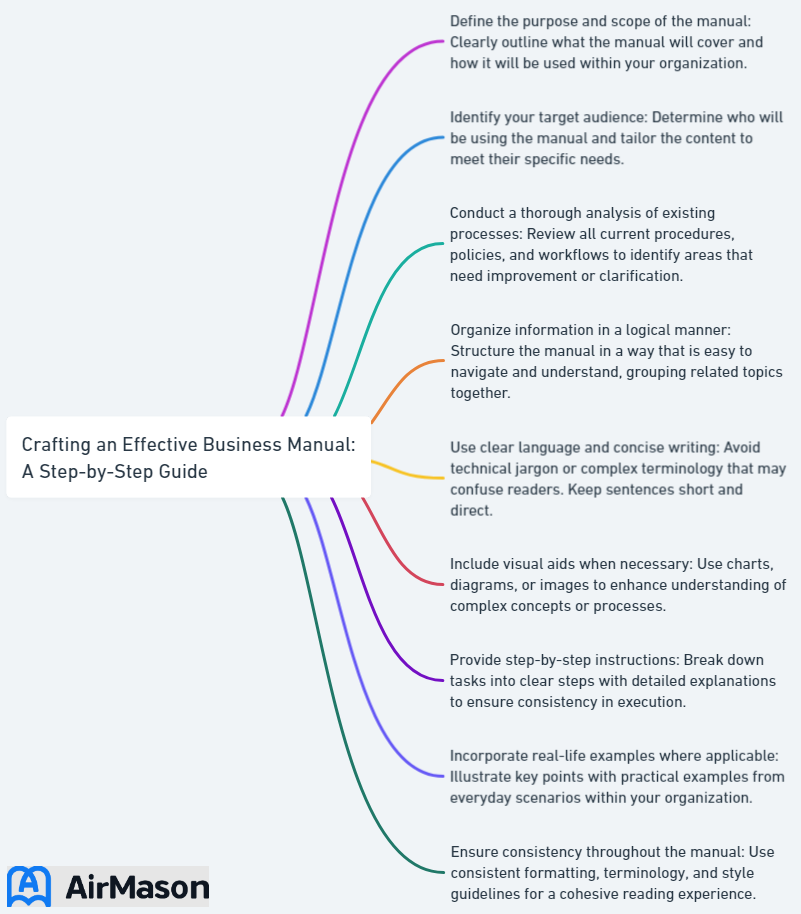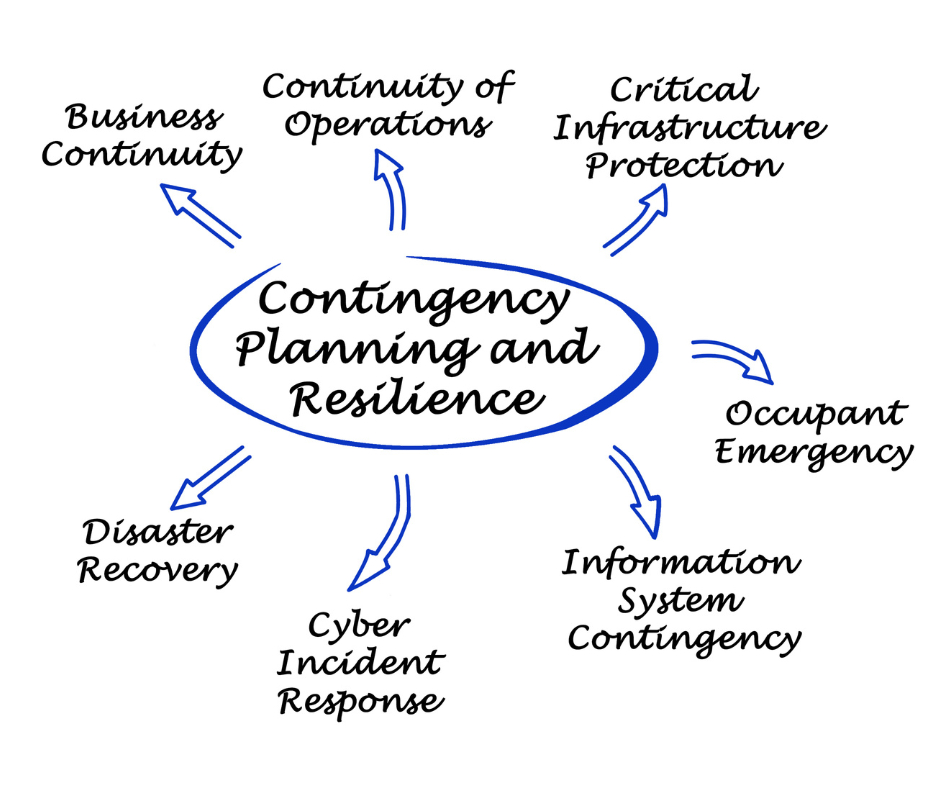
Imagine running a successful business where your team operates like a well-oiled machine. Every employee knows exactly what to do, and your processes are streamlined, efficient, and error-free. This ideal scenario is achievable with the help of a comprehensive and well-written operations manual. In this blog post, we will explore the importance of a business manual, its key components, and the step-by-step process of creating one. Plus, we will discuss the best tools and platforms to use and share tips for maintaining and updating your manual.
Key Takeaways
- Business manuals provide a framework for uniformity and efficiency, enabling optimized processes and providing a repository of information.
- Creating an effective business manual includes setting clear goals & objectives, collaborating with multiple teams, designing consistent layout/formatting & choosing the right platform/tools.
- Regular reviews, updates & employee feedback are essential to maintain its effectiveness.
Understanding the Importance of a Business Manual
A business manual is essential for:
- Maintaining uniformity
- Optimizing processes
- Providing a repository of information for personnel
- Guaranteeing efficient operations and expansion
It is the backbone of your company’s processes and serves as a how-to guide for both new and experienced employees.
A well-written operations manual paves the way for consistency across departments, streamlined processes, and reduced errors, which all contribute to smooth business operations and growth.

Ensuring Consistency Across Departments
The incorporation of processes into an emergency operations manual template promotes uniformity and productivity in task completion. Standardizing workflows and processes across departments can help to eliminate misunderstandings, ensure all teams are aligned, and minimize confusion.
A clear and comprehensive operations manual, also known as an operation manual, is like a recipe book for your business, ensuring that each department follows the same page, leading to efficient process delivery and a harmonious work environment. Utilizing a restaurant operations manual template can help streamline this process for your establishment.
Streamlining Processes and Reducing Errors
Clear and concise instructions and guidelines within a well-crafted business manual can minimize errors and optimize processes. Visualizing processes through process maps, flowcharts, and BPMN diagrams is an effective approach to process documentation, ensuring that all steps are properly documented and easily understood.
The inclusion of visual aids such as diagrams and illustrations simplifies understanding of even the most complex processes for employees, helping them execute tasks flawlessly on multiple occasions.
Providing a Knowledge Base for Employees
Acting as a valuable knowledge base, a comprehensive business manual enables employees to perform their tasks with efficiency and independence, serving as a crucial component of employee training. It is a one-stop-shop for all the information they need, from company policies and procedures to emergency response procedures.
The inclusion of contact information in a business manual has several benefits:
- It makes it easier for employees to reach out to the appropriate personnel.
- It saves time by providing a centralized resource.
- It empowers employees and contributes to their job satisfaction.
- It ultimately contributes to the overall success of the company.
Procedure Manual Examples
When seeking guidance on creating effective procedural documentation, examining procedure manual examples can be immensely beneficial. These examples serve as tangible models that showcase the structure, formatting, and content necessary for a well-organized and comprehensible procedure manual. By studying such examples, one can grasp how to outline procedures, elucidate steps, and integrate visual aids, making the manual more user-friendly. Additionally, reviewing diverse procedure manual examples can shed light on the varying approaches and styles one can adopt to cater to specific organizational needs or industry requirements. Analyzing these examples facilitates a clearer understanding of how to articulate processes, responsibilities, and protocols within a procedural document, ultimately aiding in the development of a comprehensive and easily navigable procedure manual.
Key Components of an Effective Business Manual

Corporate regulations and processes, organizational hierarchy and responsibilities, as well as emergency protocols and alternative plans should all be covered in an effective business operations manual. By covering all aspects of your business operations, your manual becomes an indispensable resource for your employees, ensuring they have the knowledge and guidance to perform their tasks efficiently.
This section delves deeper into the three key components of a successful business manual.
Company Policies and Procedures
The inclusion of company policies and procedures in a business manual fosters a consistent and productive work environment by ensuring employees are aware of and comply with the established regulations.
An operations manual, along with other operations manuals, should comprise:
- All standard operating procedures (SOPs)
- Hierarchy
- Contact details
- Emergency procedures
Having a well-written operations manual that covers all the specific procedures of your business ensures employees understand their responsibilities and adhere to the guidelines set forth by the company.
Organizational Structure and Job Roles
A clear definition of the organizational structure and job roles in a business manual fosters effective communication and collaboration by helping employees understand their responsibilities and reporting lines.
An organizational chart is a useful tool that provides a visual representation of the company hierarchy and reporting relationships among employees. By outlining the chain of command and delineating who is responsible for each task, the manual promotes efficient communication and cooperation across multiple departments.
Emergency Protocols and Contingency Plans

The inclusion of emergency protocols and contingency plans in a business manual equips employees to handle unexpected situations, thereby minimizing potential damage and disruptions to operations. Procedures for likely emergencies should be outlined, such as who to contact, how to manage insurance, and HR and client/customer protocols.
By having these plans in place, your team will be better equipped to respond promptly and efficiently to any unforeseen events, ensuring your business runs smoothly even in the face of adversity.
Office Procedure Manual
An office procedure manual, also known as an administrative manual or office operations guide, serves as a comprehensive document outlining the protocols, processes, and guidelines essential for efficient functioning within an office environment. This manual is an indispensable tool that encapsulates the standardized methods and steps employees should follow when executing their respective tasks and responsibilities. The office procedure manual typically covers a wide array of topics, including but not limited to, administrative workflows, communication protocols, document handling, meeting procedures, and safety regulations. Its primary purpose is to streamline operations, enhance productivity, and ensure consistency across various aspects of office operations. Regular updates and reviews of the office procedure manual are crucial to keeping it relevant and aligned with organizational goals and evolving workplace dynamics.
Creating Your Business Manual: A Step-by-Step Process

Creating a comprehensive and user-friendly business manual may seem like a daunting task, but it doesn’t have to be. By following a step-by-step process and focusing on clear goals and objectives, collaboration with multiple teams, and a consistent layout and format, you can create an effective operations manual that will guide your organization’s operations.
This section explores each step in detail, serving as your roadmap to success.
Setting Clear Goals and Objectives
Clear goals and objectives for your business manual guide its creation and ensure it effectively addresses the needs of your organization and employees. By setting SMART (Specific, Measurable, Achievable, Relevant, and Time-bound) goals, you can create a roadmap that outlines the purpose, scope, and intended outcomes of your manual.
This clarity of purpose will not only keep you focused during the creation process but also ensure that your manual provides value to your team.
Collaborating with Multiple Teams
The involvement of multiple teams in the creation of your business manual guarantees coverage of all aspects of your operations and accuracy of the information provided. Engaging subject matter experts, managers, supervisors, experienced employees, and representatives from various departments or teams in the creation process will help you build a comprehensive and reliable manual.
By fostering collaboration and open communication, you can create an operations manual that truly reflects the needs and expertise of your organization.
Designing a Consistent Layout and Format
Better navigation and understanding of your business manual, and consequently its effectiveness as a resource for employees, are ensured by a consistent layout and format. When constructing a business manual layout, consider elements such as:
- Mission and vision statements
- Company goals
- Legal information
- Hierarchy and organizational structure
- Job descriptions
- Processes and procedures
- Company hours of operation
- Contact information
By ensuring a polished and uniform appearance, your manual will not only be more user-friendly but also project a professional image that reflects your organization’s commitment to excellence.
Choosing the Right Platform and Tools for Your Business Manual

The platform and tools you choose for your business manual can greatly impact its accessibility, ease of use, and overall effectiveness. This section discusses two main options for platforms and tools – digital platforms and cloud-based solutions, and templates and software tools.
Selecting the right platform and tools for your manual will ensure that it is easy to update, distribute, and access, making it an invaluable resource for your team.
Digital Platforms and Cloud-Based Solutions
Easy updates and distribution of your business manual, along with constant employee access to the most current information, are facilitated by digital platforms and cloud-based solutions. These solutions provide advantages such as:
- Access to open and shared data for intelligent analysis
- Faster innovation and higher quality solutions
- Increased reliability and task transparency
- Access to digital content from any location
Some leading digital platforms and cloud-based solutions include Document360 and Bit, providing you with powerful tools to create and manage your business manual.
Templates and Software Tools
Templates and software tools can expedite the creation of your business manual while maintaining a professional and consistent appearance. Templates provide a standardized format and structure for the manual, while software tools often have additional features to aid in the creation process.
Recommended software tools for creating a business manual include:
- KnowledgeBase
- ClickHelp
- Scribe
- Document360
- Dozuki
- Nuclino
- Paligo
- ProProfs
- Archbee
- Adobe FrameMaker
By leveraging these tools, you can streamline the process of creating a comprehensive and polished operations manual, such as a construction operations manual template, a financial operations manual template, or a hotel operations manual template.
Templates for Training Manuals
When developing training materials, utilizing predefined templates for training manuals can significantly streamline the content creation process. These templates for training manuals serve as structured frameworks that guide the organization and presentation of information, ensuring a consistent and cohesive training experience for the learners. They often encompass sections for introductions, learning objectives, instructional content, exercises, assessments, and supplementary resources. Utilizing such templates not only enhances the efficiency of content creation but also promotes clarity and uniformity in conveying essential training concepts. Moreover, these templates can be customized based on the specific needs of the training program, making them versatile tools for instructional designers and trainers alike.
Tips for Maintaining and Updating Your Business Manual

Keeping your business manual up to date and relevant once it’s created ensures its continued effectiveness as a guiding resource for your organization. This section shares tips for maintaining and updating your manual, such as conducting regular reviews and updates, and encouraging employee feedback.
By following these tips, you can ensure that your manual remains a valuable asset for your team.
Regular Reviews and Updates
Regular reviews and updates of your business manual help it stay current and reflect changes in processes, policies, or technologies. It is recommended to review policies and procedures quarterly or annually to keep them up to date.
By staying on top of industry regulations and changes in your business processes, you can ensure that your manual continues to be a valuable resource for your employees and helps keep your business running smoothly.
Encouraging Employee Feedback
Employee feedback on your business manual encourages continuous improvement and helps keep the document a valuable resource for your team. By soliciting feedback, you can identify areas for improvement, address any gaps in the manual, and make strategic changes based on employee insights.
This collaborative approach not only keeps your manual up to date but also fosters a sense of ownership and engagement among employees, ultimately contributing to the overall success of your organization.
Summary
In conclusion, a well-crafted business manual is an invaluable asset for any organization, ensuring consistency, streamlining processes, and providing a comprehensive knowledge base for employees. By following the step-by-step process outlined in this blog post, choosing the right platform and tools, and maintaining and updating your manual, you can create a resource that will guide your organization’s operations and contribute to its success. So, take the first step towards creating an effective business manual today and watch your team’s productivity and efficiency soar!
Frequently Asked Questions
What should be in a business manual?
A business manual should include standard sections such as work policies, business processes, organizational hierarchy, roles and responsibilities, emergency response process, and contact information. Additionally, documents processes, job descriptions, and regular updates must also be included.
What is included in an operations manual?
An operations manual is a document that outlines the specific procedures needed to run a business smoothly, including operation instructions from handling customer inquiries to day-to-day tasks such as responsibilities, procedures and processes.
Why is manual important in business?
Manuals are essential in business as they outline important information and procedures that employees need to understand and follow. They also help save time, reduce mistakes, improve efficiency, train new employees, reduce liability risks, and add value to the company.
How can a business manual help streamline processes and reduce errors?
A business manual provides clear instructions, guidelines, and visual aids for employees to follow, helping streamline processes and reduce errors.
How can digital platforms and cloud-based solutions benefit a business manual?
Digital platforms and cloud-based solutions can help make sure employees always have access to the most up-to-date business manual, enabling them to stay informed and work more efficiently.